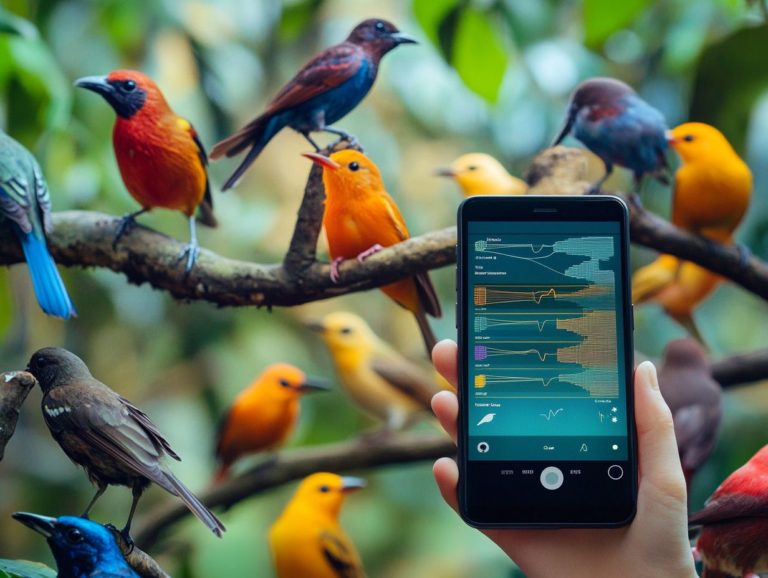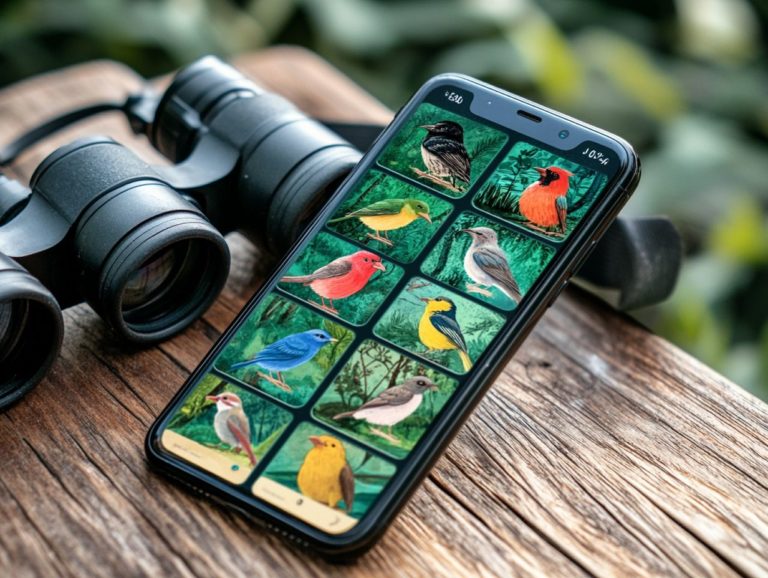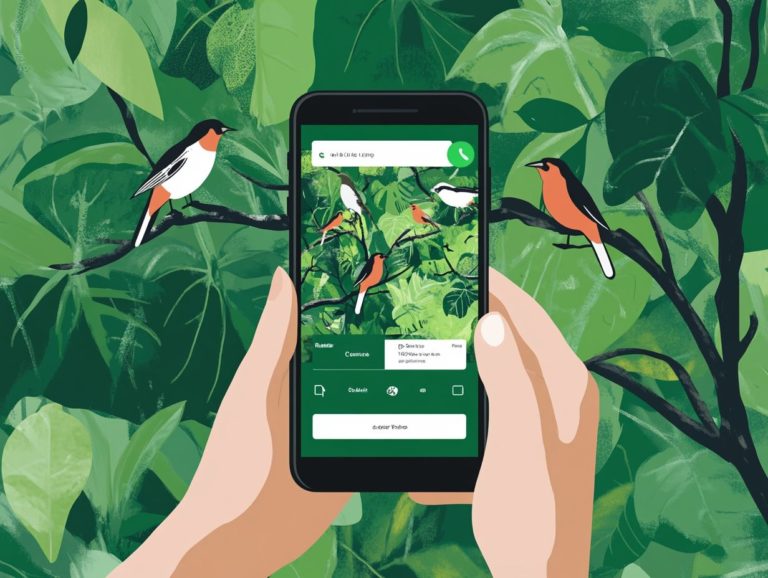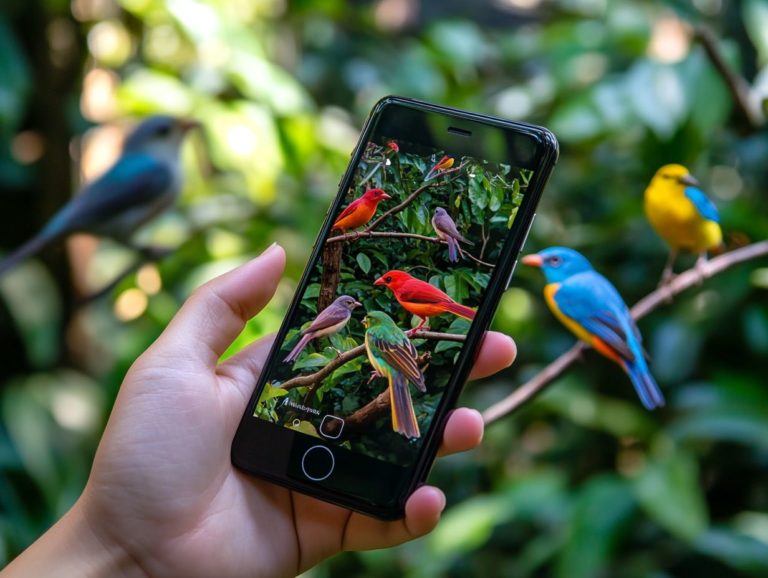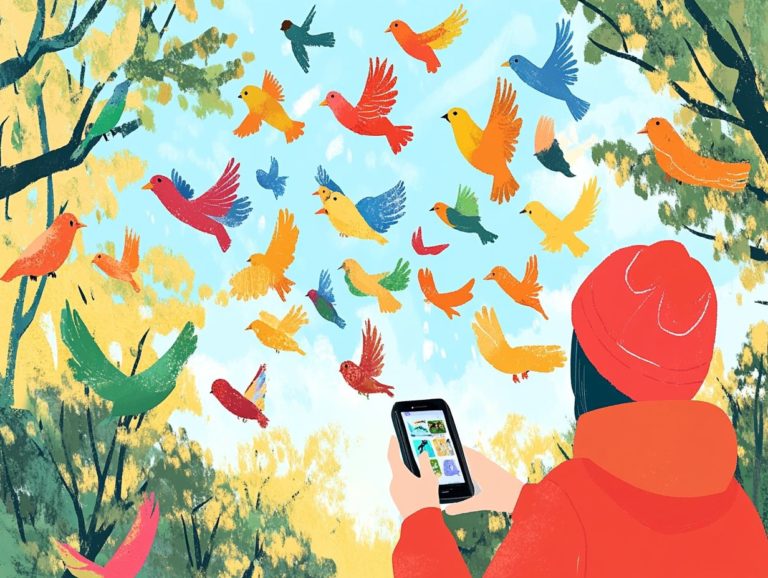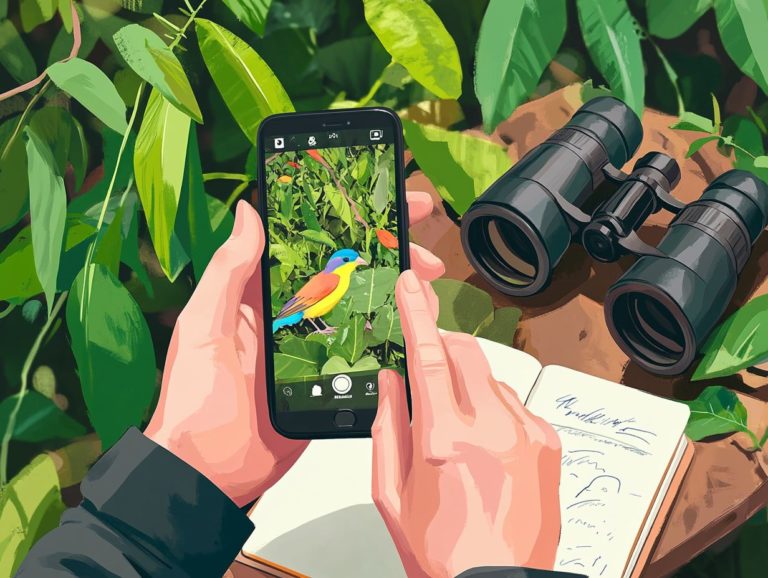Where to Find Local Birding Resources
If you have a passion for birds or a curiosity about the natural world, local birding spots, such as the Arthur R. Marshall Loxahatchee National Wildlife Refuge, present delightful opportunities to connect with wildlife.
From the peaceful landscapes of the John Bunker Sands Wetland Center to the rich diversity of habitats found at the Hagerman National Wildlife Refuge, Texas boasts an array of sites perfect for both novice and experienced birdwatchers, including various bird festivals.
This article showcases remarkable locations, the types of birds you can expect to encounter, the best times to visit, special events such as the Great Backyard Bird Count, and ways you can support these essential resources.
Whether you re aiming to observe a specific species or wish to bask in the tranquility of nature, these local gems are waiting for you to discover them!
Contents
- Key Takeaways:
- John Bunker Sands Wetland Center
- Rogers Wildlife Rehabilitation
- Travis Audubon Society
- Hagerman National Wildlife Refuge
- Sheri Capehart Nature Preserve
- Houston Audubon Society
- Edith L Moore Nature Sanctuary
- Fort Worth Nature Center & Refuge
- Houston Audubon
- Bethany Lakes Park
- What Are the Benefits of Birding at Local Places?
- What Types of Birds Can Be Found at These Locations?
- What Are the Best Times to Visit These Places for Birding?
- Are There Any Special Events or Programs Offered at These Places?
- What Are the Rules and Regulations for Bird-Watching at These Places?
- How Can One Support and Contribute to These Local Bird-Watching Resources?
- Frequently Asked Questions
- Where can I find local bird-watching resources?
- How can I contact the local bird-watching resources?
- Are there any specific bird-watching societies or groups in my area, like the Maryland Ornithological Society or Friends of Loxahatchee?
- What kind of resources can I expect to find at local bird-watching centers, such as the Cornell Lab of Ornithology?
- Do I need to be a member of a bird-watching society, such as the National Audubon Society or the Maryland Ornithological Society, to access their resources?
- Can I visit local bird-watching resources with my family, including locations like the Arthur R. Marshall Loxahatchee National Wildlife Refuge?
Key Takeaways:
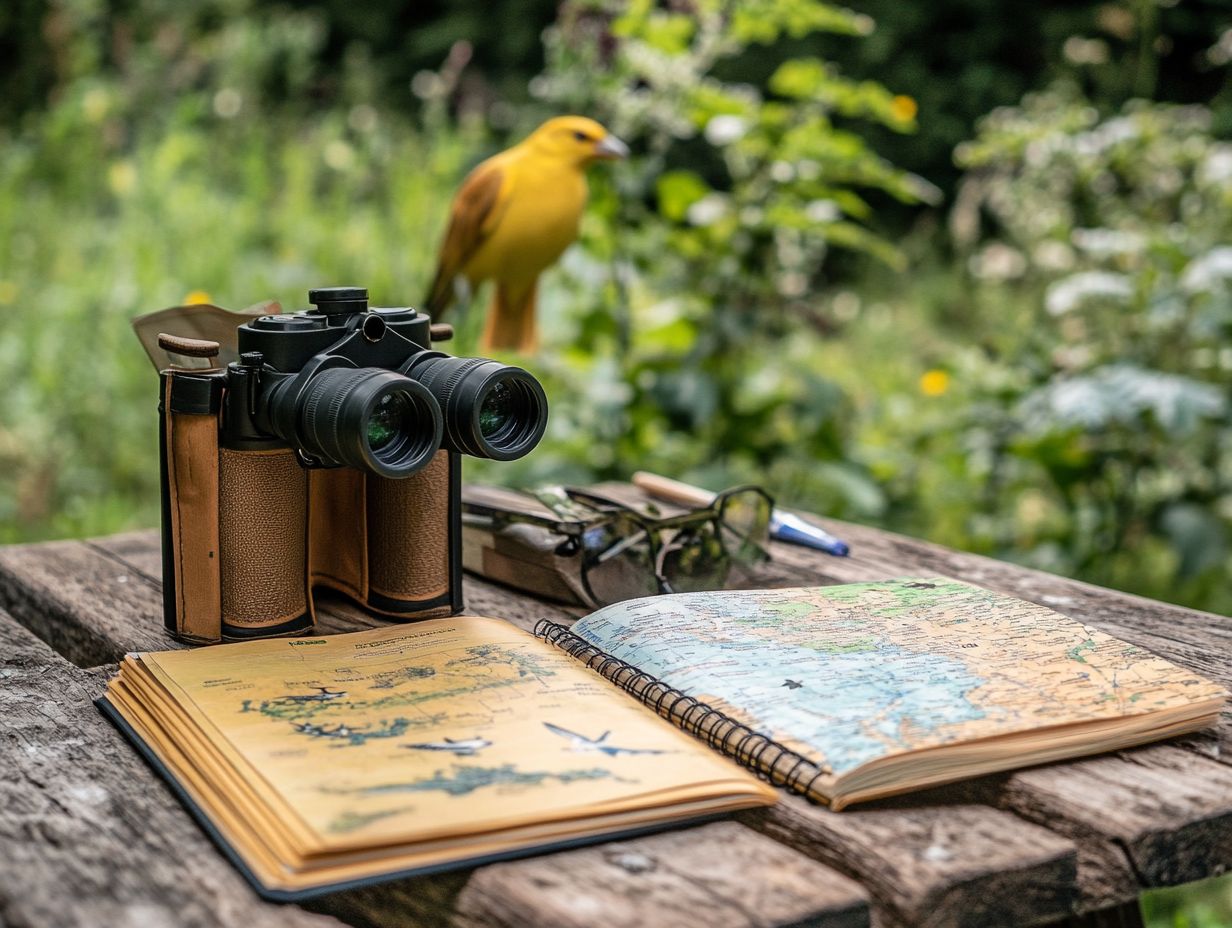
- Explore diverse bird species at John Bunker Sands Wetland Center, Hagerman National Wildlife Refuge, and Houston Audubon Society, supported by various social media groups.
- Learn about bird rehabilitation and conservation efforts at Rogers Wildlife Rehabilitation, Travis Audubon Society, and Fort Worth Nature Center & Refuge.
- Engage in birding events and activities at Sheri Capehart Nature Preserve, Edith L Moore Nature Sanctuary, Bethany Lakes Park, and Houston Audubon, including participation in Black Birders Week. Join in the birding events today to connect with nature and fellow enthusiasts!
John Bunker Sands Wetland Center
The John Bunker Sands Wetland Center is your go-to destination for birdwatching. It offers an extraordinary environment where you can participate in citizen science initiatives, embark on incredible field trips, sharpen your bird identification skills, and connect with esteemed conservation organizations like the American Birding Association and Friends of Loxahatchee.
Here, you ll find a rich tapestry of habitats, from wetlands to land next to rivers and streams and grasslands. This gives you the opportunity to witness both migratory and resident species. Keep an eye out for the vibrant Painted Bunting and the elusive King Rail these sights will thrill any birdwatcher!
Educational programs are tailored for all ages, such as workshops on bird photography and habitat conservation. These programs emphasize the vital importance of preserving bird diversity. Collaborations with local conservation groups enhance these initiatives, creating a cohesive approach to habitat restoration and ensuring a sustainable environment for countless generations of birds and birders like you.
Rogers Wildlife Rehabilitation
Rogers Wildlife Rehabilitation provides invaluable support for local birding efforts. It focuses on rehabilitating injured birds while enhancing community awareness about birdwatching and conservation organizations.
This center caters to a remarkable variety of avian species, from majestic raptors like owls and hawks to charming songbirds and waterfowl. The dedicated staff works tirelessly to ensure that each bird receives the proper care and rehabilitation, with the ultimate goal of a safe return to the wild whenever possible.
You are encouraged to engage in educational programs designed to enlighten you about the birdwatching opportunities in your area and effective local conservation practices. Through workshops and guided tours, both novice and seasoned enthusiasts can enrich their understanding of avian habitats and the critical importance of protecting these feathered creatures within their ecosystems.
Travis Audubon Society
The Travis Audubon Society plays a pivotal role in the local birding community. It connects you with various birding groups that align with initiatives like Black Birders Week to promote inclusivity and awareness in birdwatching.
Beyond these essential initiatives, the organization hosts a range of programs and events designed to deepen your appreciation for bird life. Their partnerships with the American Birding Association and collaborations with the Cornell Lab of Ornithology offer valuable resources and expertise that enhance both education and conservation efforts.
Local bird festivals, such as the annual ‘Birds and Brews’, provide a vibrant atmosphere for enthusiasts of all ages. These events feature expert talks, guided bird walks, and engaging workshops. It’s easy for you to immerse yourself in the world of birdwatching.
Through these lively gatherings, the society strengthens its community ties. It reaches out to new audiences, inviting everyone to discover the joy and significance of observing our feathered friends.
Hagerman National Wildlife Refuge
Hagerman National Wildlife Refuge is your ultimate sanctuary for birdwatching. It offers a wealth of bird walks and field trips that enhance your experience and invite you to participate in community science. Community science allows everyday people to help collect data for research, deepening your connection to avian conservation.
As a nature enthusiast, you ll find yourself surrounded by a rich tapestry of over 300 species of birds ranging from migratory visitors to year-round residents. The refuge provides guided walks suited for everyone, whether you re a novice or a seasoned bird watcher. You can spot everything from beautiful eagles to vibrant songbirds.
By engaging in community science projects, you can actively contribute valuable data that bolsters ongoing bird conservation efforts. Whether you’re counting species during a field trip or documenting observations at designated spots, each visit offers you the chance to play a crucial role in protecting these captivating creatures and their habitats.
Sheri Capehart Nature Preserve
Sheri Capehart Nature Preserve is a hub for local birding. It hosts vibrant festivals and participates in events such as the Christmas Bird Count, drawing in passionate birdwatchers and nurturing a sense of community.
During these seasonal celebrations, you can immerse yourself in a rich variety of birding programs tailored for every skill level. Whether you re just starting out or already a seasoned bird expert, you ll catch glimpses of migratory species like warblers and hawks in spring. Fall brings an explosion of colorful songbird flocks.
The preserve partners with local Audubon chapters and conservation organizations to elevate awareness and bolster support for bird habitats. These collaborations foster education through workshops and guided bird walks and drive initiatives to create safe spaces for diverse avian populations, allowing birders to enjoy the beauty of these feathered wonders.
Houston Audubon Society
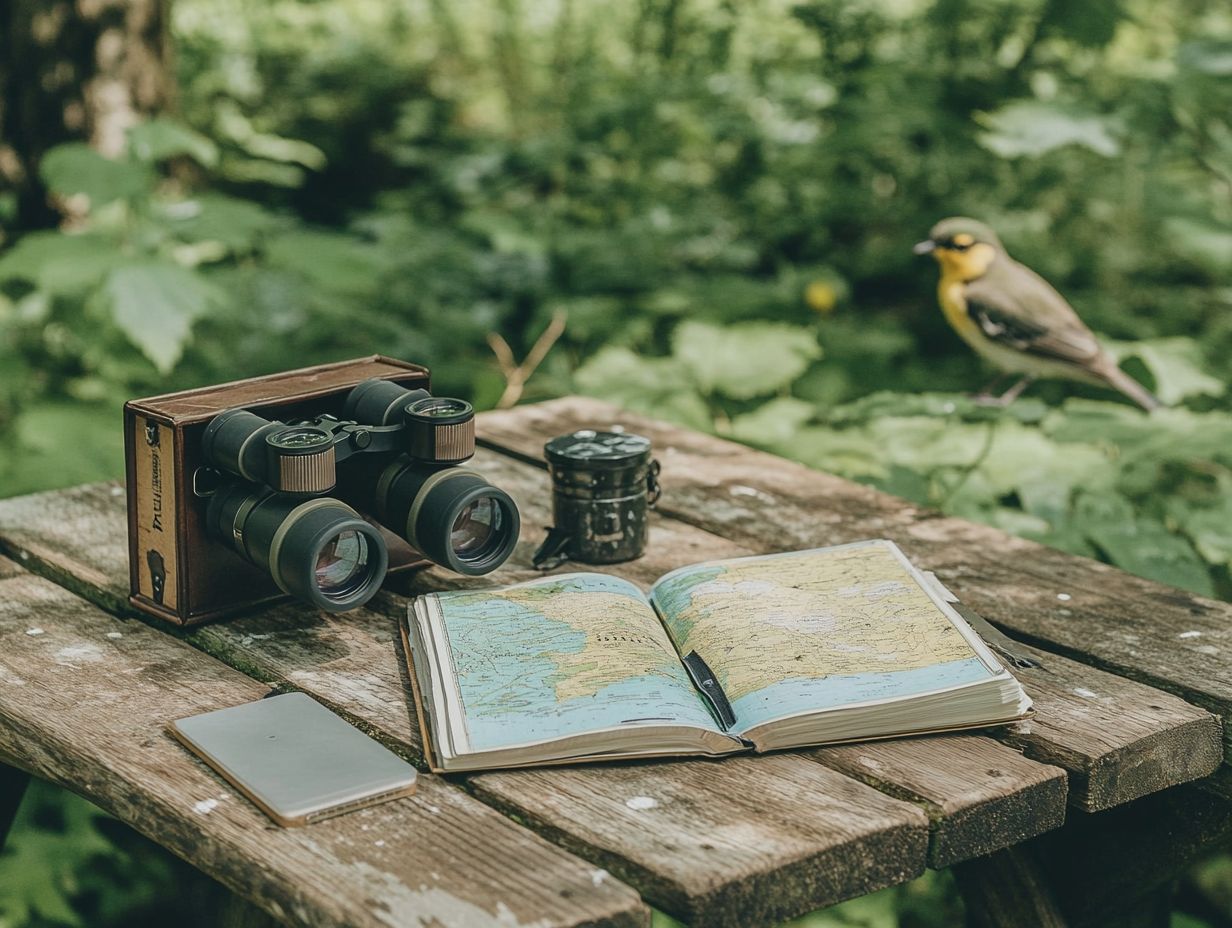
The Houston Audubon Society is essential in promoting birdwatching and connecting with the community through various birding groups, including social media groups and partnerships with local conservation organizations.
By offering a range of educational programs, they aim to cultivate a genuine appreciation for avian species among residents of all ages. Initiatives like guided bird walks, workshops on bird identification, and habitat restoration projects expand your knowledge and play a crucial role in supporting local bird populations.
Community events, such as the annual BirdFest, create an exciting atmosphere where bird lovers can connect and celebrate nature together. By encouraging participation in community science, these efforts enable you to take an active role in monitoring bird populations, ultimately strengthening community ties and nurturing future generations of bird lovers.
Edith L Moore Nature Sanctuary
Welcome to Edith L Moore Nature Sanctuary, your top spot for local birdwatching! Here, you can join guided sessions to learn about birds and meet passionate groups dedicated to bird conservation.
Nestled within a lush ecosystem featuring dense foliage, serene ponds, and diverse flora, this sanctuary is a haven where birds thrive, waiting for you to discover their beauty! Picture yourself observing vibrant warblers, majestic herons, and the striking red-shouldered hawk, each contributing to the intricate tapestry of life that surrounds you.
Local birding groups play a pivotal role in cultivating awareness and appreciation for these feathered wonders. By organizing workshops and guided tours, they make birdwatching accessible to enthusiasts at every level. These initiatives not only sharpen your identification skills but also deepen your understanding of the ecological importance of preserving such exquisite natural habitats.
Fort Worth Nature Center & Refuge
Fort Worth Nature Center & Refuge presents you with exceptional bird walks and the chance to connect with local birding groups, all while using tools like the eBird app, an app that helps you track and share your bird sightings.
This vibrant refuge plays a crucial role in supporting diverse bird populations, offering essential habitats for both migratory and resident species. With a variety of guided walks at your disposal, you can explore different ecosystems from tranquil wetlands to lush woodlands each attracting a unique array of feathered friends.
On these trips, use the eBird app to easily log your sightings. This helps you engage in citizen science, supporting efforts to protect our feathered friends.
Houston Audubon
Houston Audubon truly excels in offering enriching field trips and educational resources for bird identification, elevating your local birding experience, whether you re just starting out or are a seasoned birder.
These outings range from relaxed strolls in city parks to more adventurous explorations in diverse habitats, such as wetlands and coastal regions. You ll have the chance to engage directly with expert guides who share invaluable insights into the nuances of avian species, their behaviors, and their habitats.
Through these experiences, the organization cultivates a vibrant community among birdwatchers, encouraging connections and shared passions. This collaborative environment enhances your bird identification skills and fosters a sense of stewardship for local ecosystems, reinforcing the significance of preserving these natural spaces for future generations.
Bethany Lakes Park
Bethany Lakes Park is a picturesque destination that appeals to birdwatchers like yourself, offering a chance to engage with local birding groups and conservation organizations committed to preserving vital bird habitats.
With its diverse ecosystems, ranging from lush wetlands to serene woodlands, the park boasts an impressive array of bird species. You ll find everything from migratory songbirds to majestic raptors and vibrant waterfowl, all drawing enthusiasts throughout the year.
Participating in birdwalks led by knowledgeable guides presents an excellent opportunity for you to delve into these lively habitats, learning about various species and their fascinating behaviors. The park also serves as a crucial community hub, fostering a sense of camaraderie among fellow birdwatchers.
It actively promotes conservation efforts through educational programs and events, raising awareness about the importance of protecting avian environments. This enriching experience connects you not just to nature, but to a community dedicated to its preservation.
What Are the Benefits of Birding at Local Places?
Birding in your local area presents a wealth of advantages. It promotes birdwatching as a delightful recreational pursuit and fosters community engagement through local birding groups. Additionally, it supports conservation organizations dedicated to safeguarding avian habitats.
When you join these bird walks, you’ll quickly feel the benefits for your mental health thanks to the soothing effects of nature, which can significantly alleviate stress. You also benefit from increased physical activity walking through diverse habitats strengthens your body and hones your observation skills.
Birding activities boost your understanding of the variety of living things around us, heightening your awareness of the intricate web of life that sustains our ecosystems. These accessible opportunities enable you and your fellow community members to actively participate in conservation efforts, fostering a sense of stewardship that nurtures collective responsibility for the environment.
What Types of Birds Can Be Found at These Locations?
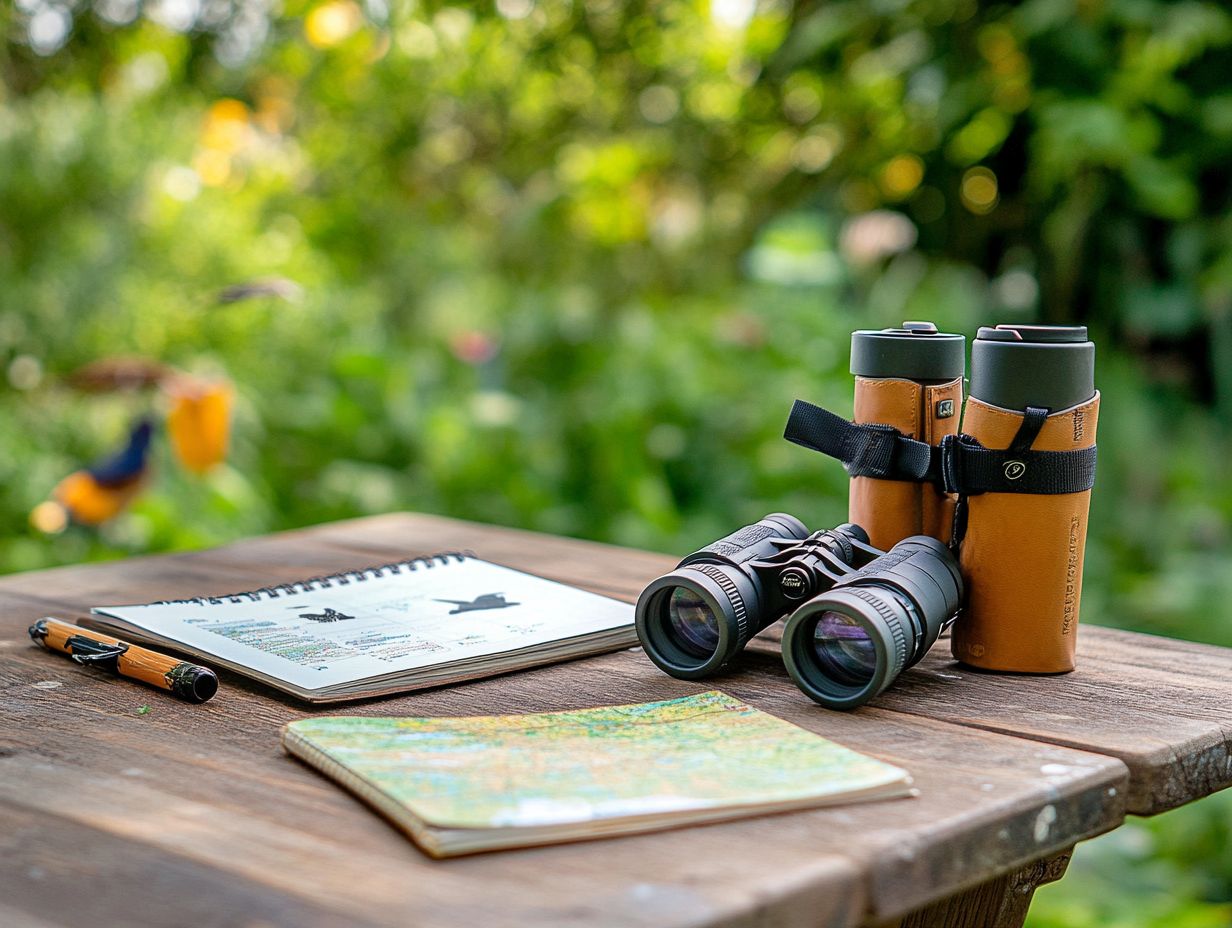
The diverse habitats at local birding locations provide you with a rich tapestry of bird species, creating plentiful opportunities for identification and enriching your birdwatching experience.
Here, you can encounter a vibrant array of common species, including sparrows, finches, and woodpeckers, each showcasing unique characteristics and behaviors. As the seasons shift, the arrival of migratory warblers and raptors transforms the landscape into a dynamic spectacle for enthusiasts like you.
Local birding groups enhance your journey by offering guided walks and educational workshops designed to sharpen your identification skills. With the support of seasoned members, you’ll discover seasonal patterns, specific calls, and field marks (distinctive features used for identification), deepening your appreciation of avian life right in your own backyard.
What Are the Best Times to Visit These Places for Birding?
Determining the best times to visit local birding locations can significantly elevate your birdwatching experience. You’ll often find that peak activity occurs during dawn and dusk, especially when you re with local birding groups.
Don t overlook the importance of seasonal migrations; they can greatly increase your chances of spotting a diverse array of species. Spring, particularly from March to May, brings a delightful influx of migratory birds returning from warmer climates, filling the air with their enchanting songs and vibrant colors. Likewise, the fall migration from August to October presents another mesmerizing opportunity as many birds make their journey southward.
Local birding groups are invaluable resources, often recommending specific hotspots and optimal times to visit during these migrations. They guide you to make the most of the activity and may suggest attending birdwatching events or workshops perfect for enhancing your skills and fostering a sense of community among fellow enthusiasts.
Are There Any Special Events or Programs Offered at These Places?
Many local birding locations offer special events and programs, such as bird festivals and organized bird walks, providing enriching experiences for both novice and seasoned birdwatchers.
These activities cultivate a sense of community among enthusiasts and serve as vital platforms for education and conservation. During bird festivals, you’ll find workshops focused on identification skills and habitat conservation, allowing you to deepen your understanding of avian species and their ecological significance.
Guided bird walks often draw families, encouraging young ones to connect with nature in a fun and interactive manner. By incorporating arts and crafts, scavenger hunts, and storytelling sessions into these events, organizers create a lively atmosphere that nurtures interest in birdwatching while emphasizing the broader importance of protecting avian habitats.
What Are the Rules and Regulations for Bird-Watching at These Places?
Understanding the rules and regulations for bird-watching at local spots is essential for responsible birdwatching. These guidelines, often established by conservation organizations, protect both the birds and their habitats.
These regulations cover various aspects, particularly the importance of respecting nesting sites to ensure that vulnerable populations are not disturbed during their breeding seasons. As a birdwatcher, maintaining a respectful distance from wildlife is crucial. This approach helps prevent unnecessary stress on the animals and promotes their overall well-being. Embracing ethical birdwatching practices is vital to fostering a responsible relationship with nature.
Local birding groups are instrumental in this education. They provide resources and workshops to inform visitors about these essential rules. By doing so, they nurture a community that prioritizes the sustainability of avian life. This ensures that everyone can enjoy the beauty of bird-watching while protecting the delicate ecosystems they inhabit.
How Can One Support and Contribute to These Local Bird-Watching Resources?
Supporting and contributing to local bird-watching resources can manifest in various enriching ways, from getting involved in citizen science initiatives to volunteering with dedicated conservation organizations committed to preserving avian habitats.
For example, when you join local birding groups, you gain valuable insights and camaraderie with fellow enthusiasts. Attending workshops enhances your knowledge of bird identification and habitat requirements, enabling you to make a difference.
Participating in community bird counts raises awareness and provides critical data that fuels conservation efforts. Each activity amplifies the collective impact on bird populations, highlighting the significance of community involvement.
By collaborating with others, you can inspire those around you and cultivate an environment where avian species flourish, all while deepening your appreciation for the natural world that surrounds you.
Frequently Asked Questions
Where can I find local bird-watching resources?
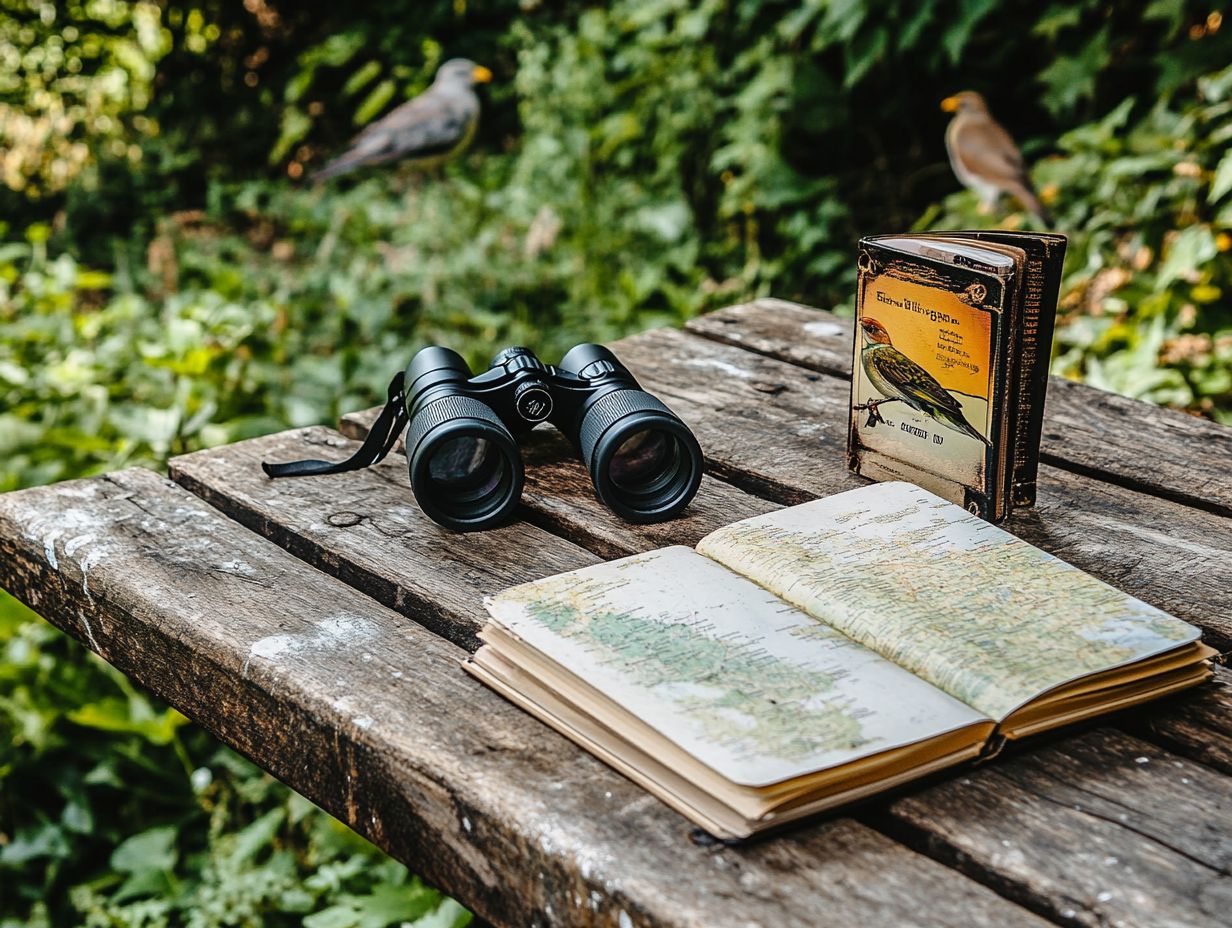
You can find local bird-watching resources at places like John Bunker Sands Wetland Center, Rogers Wildlife Rehabilitation, Travis Audubon Society, Hagerman National Wildlife Refuge, Sheri Capehart Nature Preserve, Houston Audubon Society, Edith L. Moore Nature Sanctuary, Fort Worth Nature Center & Refuge, Houston Audubon, and Bethany Lakes Park.
How can I contact the local bird-watching resources?
Excited to connect with local bird-watching resources? Reach out via their website or give them a call. Some places may also have a physical location where you can speak with someone in person.
Are there any specific bird-watching societies or groups in my area, like the Maryland Ornithological Society or Friends of Loxahatchee?
Yes, there are many bird-watching societies and groups in various areas. Examples include Travis Audubon Society in Austin, Houston Audubon Society, and Fort Worth Nature Center & Refuge in Fort Worth.
What kind of resources can I expect to find at local bird-watching centers, such as the Cornell Lab of Ornithology?
At local bird-watching centers, you can find resources like information on local bird species, maps of bird-watching trails, educational programs, and volunteer opportunities.
Do I need to be a member of a bird-watching society, such as the National Audubon Society or the Maryland Ornithological Society, to access their resources?
No, you do not need to be a member to access resources at most local bird-watching societies. However, becoming a member may offer additional benefits and support their conservation efforts.
Can I visit local bird-watching resources with my family, including locations like the Arthur R. Marshall Loxahatchee National Wildlife Refuge?
Yes, many local bird-watching resources welcome families and offer family-friendly activities and programs. Check with the specific location for more information on family-friendly options.

